German Figures in the Warsaw Ghetto Uprising
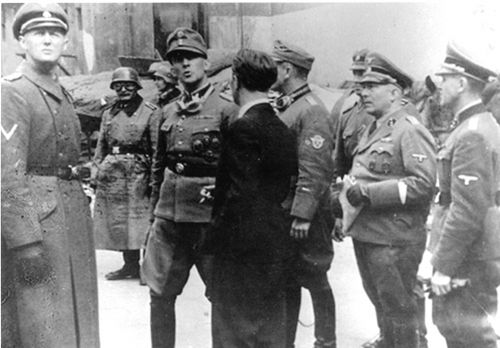
Franz Konrad, Jurgen Stroop, Karl-Georg Brandt -
Pictured during the Warsaw Ghetto Uprising (USHMM Archives)
Dr. Ferdinand von Sammern-Frankenegg
Von Sammern was born in Greiskirchen in Upper Austria on March 17, 1897. During the First World War he served in the 1st Kaiserschutzen Regiment and the 9th Feldjager Battalion as a mountain infantry lieutenant. He was a prisoner of war from November 1918 to September 1919, in Italy. Von Sammern received a law degree from the University of Innsbruck. He joined the SS on December 1, 1932, where he received the SS membership number of 292792. On March 1, 1933, he joined the German Nazi Party, he had previously joined the Austrian Nazi Party on June 1, 1932.
Von Sammern was promoted to the rank of SS-Untersturmfuhrer on April 20, 1935, and then to the rank of SS-Obersturmfuhrer on November 9, 1936, another promotion soon followed on April 20, 1937, when he became an SS-Hauptsturmfuhrer, and again in the same year on November 9, 1937, when he became an SS-Sturmbannfuhrer. He skipped the rank of SS-Obersturmbannfuhrer, and was promoted directly to the rank of SS-Standartenfuhrer on March 17, 1938.
Von Sammern served as a commander of various SS districts in Germany before the outbreak of the Second World War. He was promoted to the rank of SS-Oberfuhrer on January 30, 1941. He assumed duties as the SS and Police Leader for Warsaw on July 22, 1942, which was the same day as the first mass Jewish resettlement actions from Warsaw to the Treblinka death camp commenced. He remained in this post and was in charge when the deportations resumed in January 1943, following Himmler's visit to Warsaw, in early January. This 'Aktion' was curtailed when the Jewish Underground rose up and disrupted the deportations. He was still performing this role of SSPF Warschau,when the Warsaw Ghetto uprising started on April 19, 1943. He was relieved of duties and replaced by Jurgen Stroop, the same day.
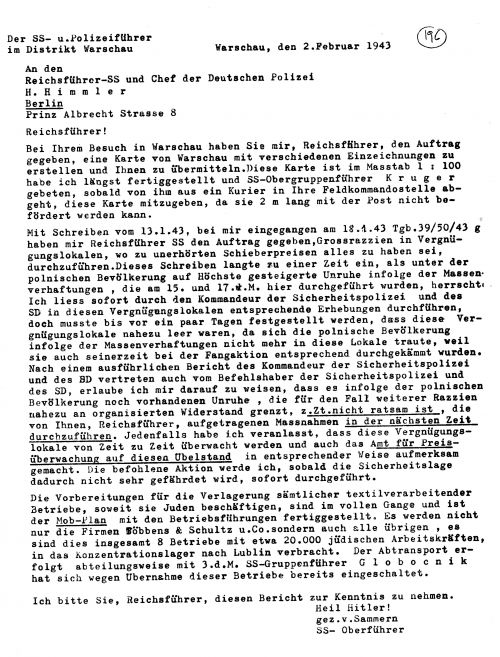
Letter from Von Sammern to Himmler re transfer of Jews to Lublin (Von Sammern personal file)
However, this move did not end Von Sammern's career, and his close friendship with Dr. Ernst Kaltenbrunner and Von Sammern then was appointed to become Heinrich Himmler's representative to the Senior Commander of German troops in Croatia. Himmler once described Von Sammern as 'from the cavalry,' very pleasant, but in no way suited to his functions'. On July 15, 1943, Von Sammern assumed duties as the SS and Police Leader 'Essegg.' Von Sammern received the award of an Iron Cross 2nd Class in 1943. He was again promoted to the rank of SS-Brigadefuhrer on April 20, 1944. He was killed in action during an artillery barrage near Banja Luka, on September 20, 1944, while visiting German and Cossack troops fighting Tito's partisans in Yugoslavia. He was posthumously awarded the Iron Cross 1st Class.
Jurgen Stroop
The biography for Jurgen Stroop is featured in the main German Biographies section
Max Jesuiter

Max Jesuiter Police Decode - December 1941
Max Jesuiter was born on August 25, 1897, in Stettin, Pomerania. During the First World War Jesuiter fought in several infantry regiments and was awarded the Iron Cross 2nd Class, and was wounded in action. He entered the Nazi Party on June 1, 1931, and his Party membership number was 551161. On January 16, 1932, he joined the SS and his SS membership number was 35007. Max Jesuiter was married but the union did not produce any children.
Jesuiter was promoted to the rank of SS-Untersturmfuhrer on November 9, 1934, and further promotions followed in quick succession; SS-Obersturmfuhrer on September 15, 1935, then to SS-Hauptsturmfuhrer on September 13, 1936, and SS-Sturmbannfuhrer on November 9, 1938. He was awarded a War Service Cross 2nd Class during 1941, and a War Service Cross 1st Class in 1943, most likely for his role during the Warsaw Ghetto uprising.During the Warsaw Ghetto Uprising he served as Chief-of-Staff to Stroop the SS and Police Leader Warsaw, who countersigned the daily reports that Stroop sent to Friedrich-Wilhelm Kruger, the Higher SS and Police Leader East for the Generalgouvernement.
His personnel file also indicates the award of a Clasp to the Iron Cross 2nd Class (given in lieu of an Iron Cross, which had been awarded to him during the First World War) and an Infantry Assault Badge. The clasp was for Max Jesuiter's role in crushing the Polish Warsaw Uprising which commenced in August 1944. He was promoted to the rank of SS-Obersturmbannfuhrer on April 20, 1944. Max Jesuiter survived the war and afterwards lived in Munich.
Karl Kaleschke
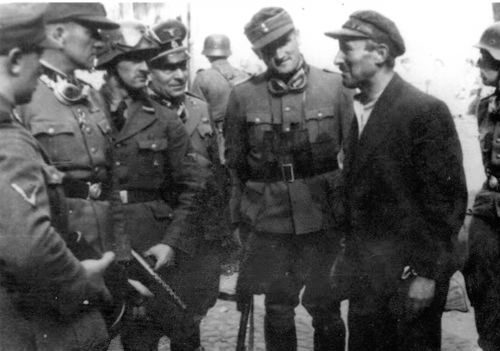
Karl Kaleschke standing next to a captured Jew in the Warsaw Ghetto (USHMM)
Karl Kaleschke was born on February 19, 1895 in Dobrin, in the Czech Republic. Karl Kaleschke served with the 61st Infantry Regiment during the First World War and he was awarded the Iron Cross 2nd Class. He was also wounded during the conflict. He entered the police during 1922 and was married in 1925. He entered the SS in 1937, and his SS membership number was 290196. He joined the Nazi Party on January 1, 1940, and his membership number was 7906104.
He was promoted to the rank of SS-Untersturmfuhrer on April 20, 1939, while serving in the Sicherheitsdienst (SD) Main Office in Berlin. Subsequently Kaleschke also served with the Gestapo in Koslin, and he served as an adjutant to Dr. Von Sammern, the SS and Police Leader in Warsaw from November 1942.
When Jurgen Stroop took over the role as SS and Police Leader for Warsaw, in April 1943, Karl Kaleschke continued in the same role, and was captured in a number of photographs taken during the Warsaw Ghetto Uprising during April and May 1943. He survived the war and in February 1946, the prosecution for the International Military Tribunal at Nuremberg, obtained an affidavit from Kaleschke that was used in evidence against Ernst Kaltenbrunner, the Head of the Security Police and SD in Berlin.
Karl Georg Brandt
Karl Georg Brandt was born on November 5, 1898, in Karlsmarkt bei Brieg. Brandt joined the Nazi Party on May 1, 1937. and was a Police Criminal Secretary in Bielefeld. After the German occupation of Poland he was appointed to the to at first the Division III of the Security Police and SD in Warsaw. From 1941, he was head of the Department IV which dealt with the Jewish question, and along with Gerhard Mende, dealt with Adam Czerniakow, the Chairman of the Warsaw Jewish Council - the Judenrat, on a daily basis.Brandt featured heavily in Adam Czerniakow's Diary.
Karl Georg Brandt, played a leading role of the Great Deportation Aktion, in the summer of 1942, and according to surviving eyewitnesses he was extremely feared. He was brutal and ruthless in the selections of Jewish people destined for deportation to the Treblinka death camp. During raids within the Warsaw Ghetto he accompanied groups of Jewish people to the Umschlagplatz, and carried out selections there, for people to go to Treblimka, or forced labour.
He also took part in deportation 'aktions' in the Warsaw district and he commanded an aktion in Otwock, where in the sanatorium Zofiowka, Gestapo men shot dead male and female patients, on August 19, 1942.
Karl Georg Brandt was killed in action in the fighting for Posen, on February 16, 1945
Franz Konrad
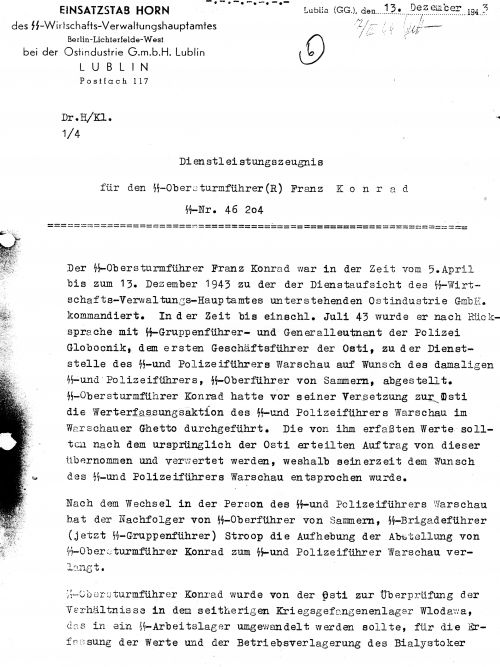
Document regarding Konrad's service in Ostindustrie GmbH (Franz Konrad personnel file)
Franz Konrad was born on March 1, 1906, in Liesing, near Vienna, Austria. He had acquired experience in business, before joining the SS. His SS membership number was 46204, which indicates he joined in July 1932. At roughly the same time he joined the Nazi Party and his Party membership number was 1085499.
Franz Konrad was promoted to the rank of SS-Untersturmfuhrer on January 30, 1939, and to the rank of SS-Obersturmfuhrer on July 1, 1941. He served in the SS-Cavalry Brigade from July 1941, to May 15, 1942, on the Eastern Front, as the food and rations supplies officer. While with this unit, he was awarded an Iron Cross 2nd Class. Konrad was then transferred to the SS Inspectorate for Cavalry and Vehicles where he served for one year.
He appears to have arrived in Warsaw during July 1942, and from September 1942, he commanded the 'Werterfassung' which was an SS enterprise devoted to collecting, sorting and storing all transportable Jewish property left behind in the deserted apartments and buildings in the Warsaw ghetto. Konrad became known as the 'King of the Ghetto,' Konrad set up dozens of them, ranging from furniture, mattresses, table and kitchenware, porcelain. There was even a book warehouse, and a musical warehouse,on Dzielna Street 35 and 69, which was visited in January 1943, by the Reichsfuhrer Heinrich Himmler
Franz Konrad was transferred to serve under Odilo Globocnik, the SS and Police Leader for the Lublin District and was employed in the SS enterprise Ostindustrie GmbH. From there he returned to Warsaw, and during the Warsaw Ghetto uprising, he was present during the crushing of the Jewish rebellion. Franz Konrad was busy during 1943, with the transformation of a former Prisoner of War camp into a labour camp at Wlodawa, which was within the Lublin District. In addition to this he was involved with the acquisition of valuables in the Bialystok Ghetto and the relocation of machinery in the rest of the Warsaw Ghetto. At the end of 1943, Franz Konrad finished his work with the Ostindustrie GmbH.
From January 3, 1944, Franz Konrad was enployed in the role of administrative head of the SS office in Schloss Fischhorn, near Zell am See, Austria. During February 1944, he was promoted to the rank of SS-Hauptsturmfuhrer.
After the Second World War ended, Franz Konrad was arrested and tried along with Jurgen Stroop in Warsaw. On March 6, 1952, both Konrad and Stroop were both executed by hanging.
Otto Hantke
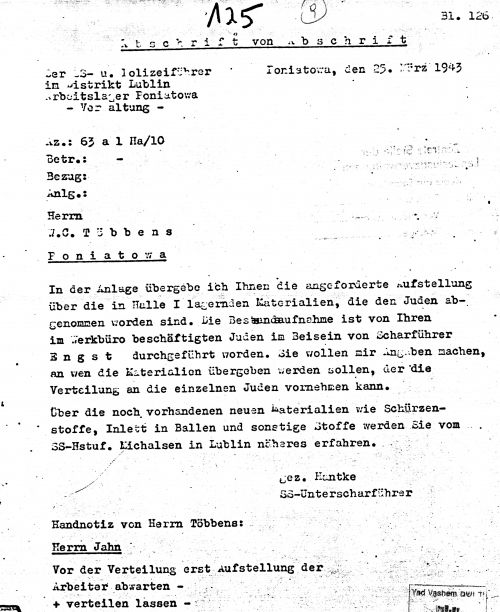
Letter regarding W.C. Toebbens (Hantke Personnel File)
Otto Hantke was born on January 21, 1907, in Katscher, Upper Silesia. Otto Hantke served as the commandant of a Jewish Labour Camp at Budzyn, where the inmates were employed at a Heinkel Aircraft factory. Hantke also served as the second commandant of the Poniatowa Labour Camp, replacing SS-Obersturmfuhrer Gottlieb Hering, who had also served as commandant of the Belzec death camp.
Otto Hantke was in Warsaw during the time of the Warsaw Ghetto Uprising in order to co-ordinate the deportation of Jewish labour to his camp in Poniatowa. He survived the war, and on July 26, 1974, a Hamburg court sentenced Otto Hantke to life imprisonment for the mass deportations of Jews from Warsaw, and other locations, to the Treblinka death camp.
SOURCES:
French L. Maclean, The Ghetto Men: The Destruction of the Jewish Warsaw Ghetto April – May 1943, Schiffer Publishing Ltd 2001
B. Engelking & J. Leociak, The Warsaw Ghetto – A Guide to the Perished City, Yale University Press, New Haven and London 2009.
K. Person, The Adventures of a Stamp Collector in the Warsaw Ghetto: The Franz Konrad Story. Holocaust Studies and Materials 3: 293-309
Photographs – USHMM
Documents - Yad Vashem, National Archives Kew
© Holocaust Historical Society 2019

